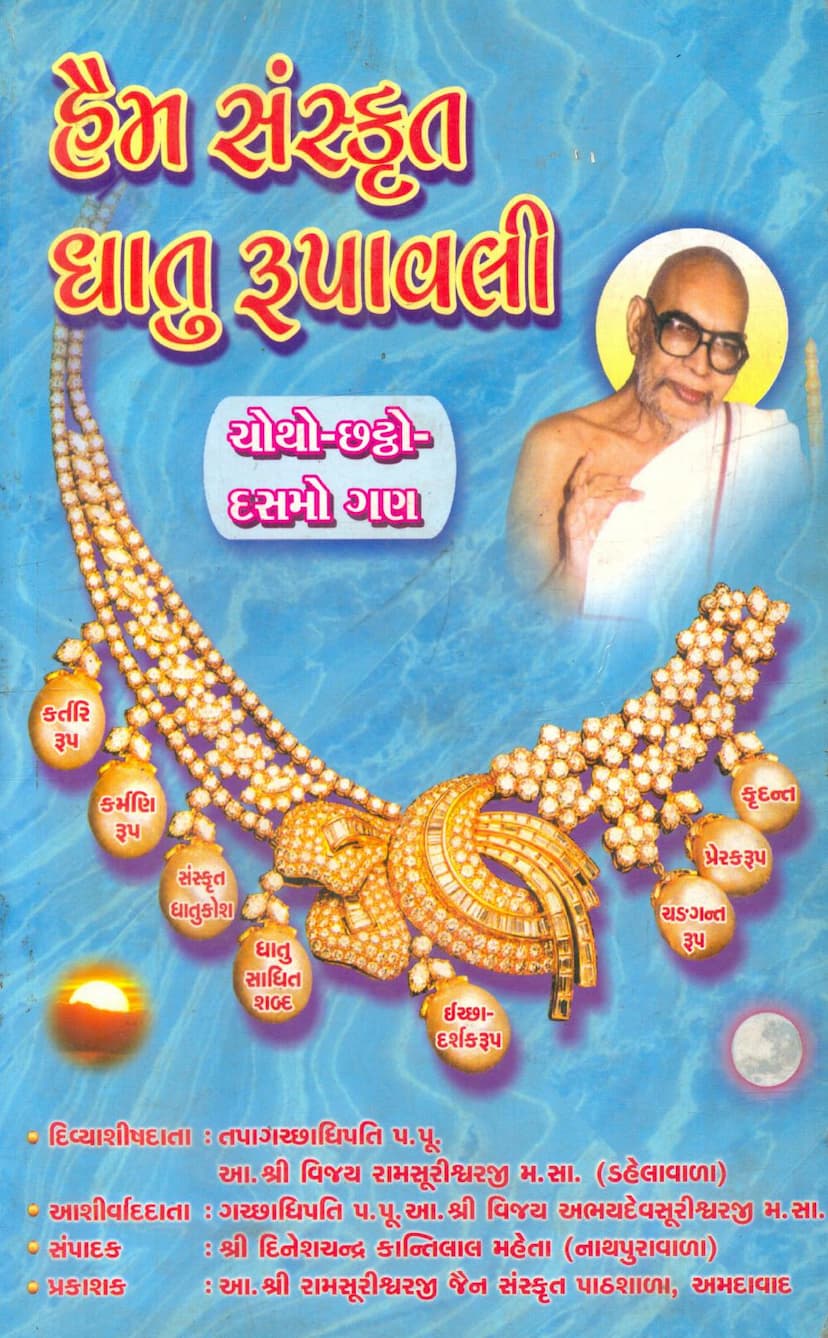Haim Sanskrit Dhatu Rupavali Part 02
Added to library: September 1, 2025

Summary
Here's a comprehensive summary of the Jain Sanskrit text "Haim Sanskrit Dhatu Rupavali Part 02" by Dineshchandra Kantilal Mehta, based on the provided pages:
Overall Purpose and Scope:
This book, "Haim Sanskrit Dhatu Rupavali Part 02," is a Sanskrit grammar guide specifically focused on the conjugation of Sanskrit roots (dhatus) according to the Haim (Hemachandra) grammar system. It is the second part of a series, building upon previous works by the author, and aims to provide a comprehensive resource for students and scholars of Sanskrit, particularly within the Jain tradition. The book aims to empower practitioners to understand and utilize the original Sanskrit texts of Jain scriptures directly, rather than relying solely on translations.
Key Figures and Support:
- Author: Shri Dineshchandra Kantilal Mehta (from Nathpura, a religious professor).
- Publisher: Shri Ramsurishwarji Jain Sanskrit Pathshala, Ahmedabad.
- Patrons/Benefactors:
- Param Pujya Tapagachhadhipati Acharya Shri Vijay Ramsoorishwarji Maharaj Saheb (from Dahela).
- Param Pujya Gachhadhipati Acharya Shri Vijay Abhaydevsoorishwarji Maharaj Saheb (from Dahela).
- Collector/Compiler: Hardik Dineshbhai Mehta.
- Special Thanks: The author expresses gratitude to individuals and groups who provided financial support for the publication and those who assisted in research and other aspects of the book's creation. This includes various Jain Sangh communities, Acharyas, Sadhvi Bhagwant, and individual scholars.
- Printing: Bharat Graphics, Ahmedabad.
Content and Structure:
The book focuses on the fourth group (gan) of Sanskrit roots in Haim grammar. It systematically presents the various forms of these roots across different conjugations and moods. The primary sections covered include:
- Dhatu Kosh (Root Lexicon): A compilation of roots.
- Dhatu Sadhita Shabda: Root-derived words.
- Krit (Participles): Various forms of participles derived from roots.
- Kartari Rupa (Active Voice Forms): Conjugations in the active voice.
- Karmani Rupa (Passive Voice Forms): Conjugations in the passive voice.
- Ichchadarshak Rupa (Optative Mood/Desiderative Forms): Forms indicating desire or wish.
- Prerak Rupa (Causative Forms): Conjugations formed by adding causative affixes to the root.
- Yadanta Rupa (Forms related to the Y-suffix): Specific grammatical formations.
- Dhatu Kosh (Root Dictionary): Explanations and meanings of roots.
- Alternative Forms (Vikalpa Rupa): Variations in root forms.
- Index (Anukramanika): A detailed table of contents listing the roots covered and their corresponding page numbers.
Grammatical Emphasis:
A key clarification made in the book is the distinction between "kaal" (tense) and "vibhaktis" (cases). The author emphasizes that while the conjugation system includes forms related to tense, the overall set of ten "vibhakti" forms is crucial, divided into:
- Tense-related: Vartamana (Present), Hyastani (Imperfect), Shwastani (Future), Paroksha (Perfect/Aorist), Adyatani (Perfect/Aorist - specific type).
- Meaning-related: Saptami (Imperative/Injunctive), Panchami (Potential), Kriyatipattyarth (Subjunctive), and Ashirvaadarth (Benedictive). The book correctly advocates for using "10 Vibhakti Rupa" instead of "10 Kaal Rupa" when referring to the complete set of conjugated forms.
Overall Significance:
"Haim Sanskrit Dhatu Rupavali Part 02" is a scholarly and devotional work, dedicated to the propagation of Shruta Gyan (scriptural knowledge). It serves as a vital tool for those seeking to delve deeply into the rich philosophical and spiritual literature of Jainism through direct engagement with the original Sanskrit texts. The author's efforts, supported by the Jain community and scholarly institutions, make this a valuable contribution to Sanskrit and Jainological studies. The book is presented as a means to achieve self-realization and ultimately, Kaivalya (liberation).